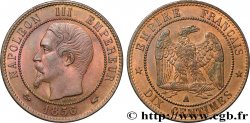fme_1028658 - SECOND EMPIRE Médaille, École impériale d’Arts et Métiers
250.00 €
Количество
Добавить в корзину

Тип Médaille, École impériale d’Arts et Métiers
Дата: 1859
Монетный двор / Город: 49 - Angers
Металл: silver
Диаметр: 41 mm
Ориентация осей монеты: 12 h.
Гравер BARRE Albert Désiré (1818-1878)
Вес: 36,34 g.
Век: lisse + main ARGENT
Пуансон: main indicatrice (1845-1860) et ARGENT
Комментарии о состоянии
Médaille nettoyée, présentant des coups et rayures, notamment sur la tranche
Ссылки в каталоге: :
Происхождение:
Collection JCT
Лицевая сторона
Аверс: легенда: NAPOLEON III - EMPEREUR.
Аверс: описание: Tête nue de profil à gauche ; signé : BARRE.
Обратная сторона
Реверс: легенда: ÉCOLE IMPÉRIALE D’ARTS ET MÉTIERS - (ANGERS) // RÉCOMPENSE / A / DAUZATS / GUILLAUME / 1859.
Реверс: Описание: Légende circulaire et en 4 lignes dans une couronne de chêne.
Комментарий
Cette médaille a été décernée à Guillaume-Vincent Dauzats (Angers 1856) (1842-1884). Dès sa sortie d’école, ce dernier entre aux usines du Creusot puis rejoint en 1861 l’entreprise Peteau, constructeur à Passy en tant que chef des études. Il sera ensuite chef du service travaux en 1873 à la Compagnie du Canal de Suez, puis ingénieur conseil dans la Compagnie du canal de Corinthe.
This medal was awarded to Guillaume-Vincent Dauzats (Angers 1856) (1842-1884). Upon leaving school, he joined the Creusot factories and then in 1861 joined the Peteau company, a construction company in Passy, as head of studies. He then became head of the works department in 1873 at the Suez Canal Company, then consulting engineer at the Corinth Canal Company.
This medal was awarded to Guillaume-Vincent Dauzats (Angers 1856) (1842-1884). Upon leaving school, he joined the Creusot factories and then in 1861 joined the Peteau company, a construction company in Passy, as head of studies. He then became head of the works department in 1873 at the Suez Canal Company, then consulting engineer at the Corinth Canal Company.








 Cообщить об ошибке
Cообщить об ошибке Распечатать страницу
Распечатать страницу Отправить мой выбор
Отправить мой выбор Задать вопрос
Задать вопрос Consign / sell
Consign / sell
 Информация
Информация














